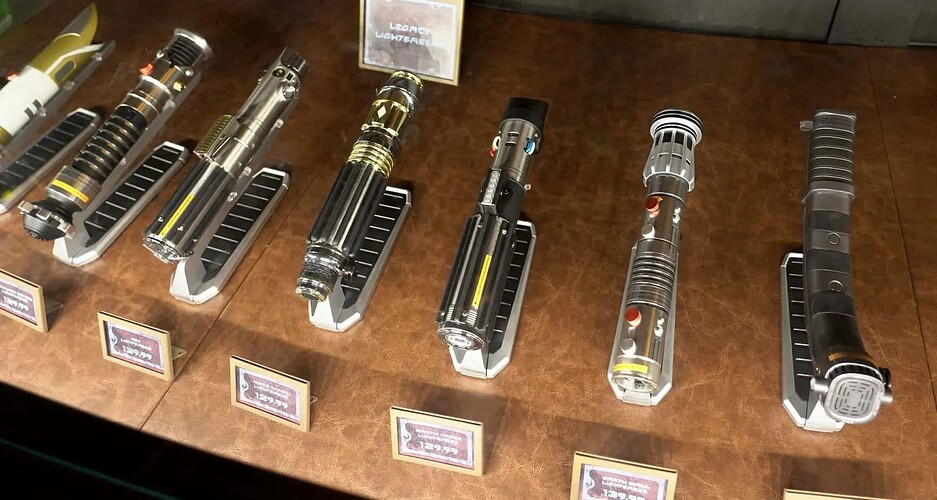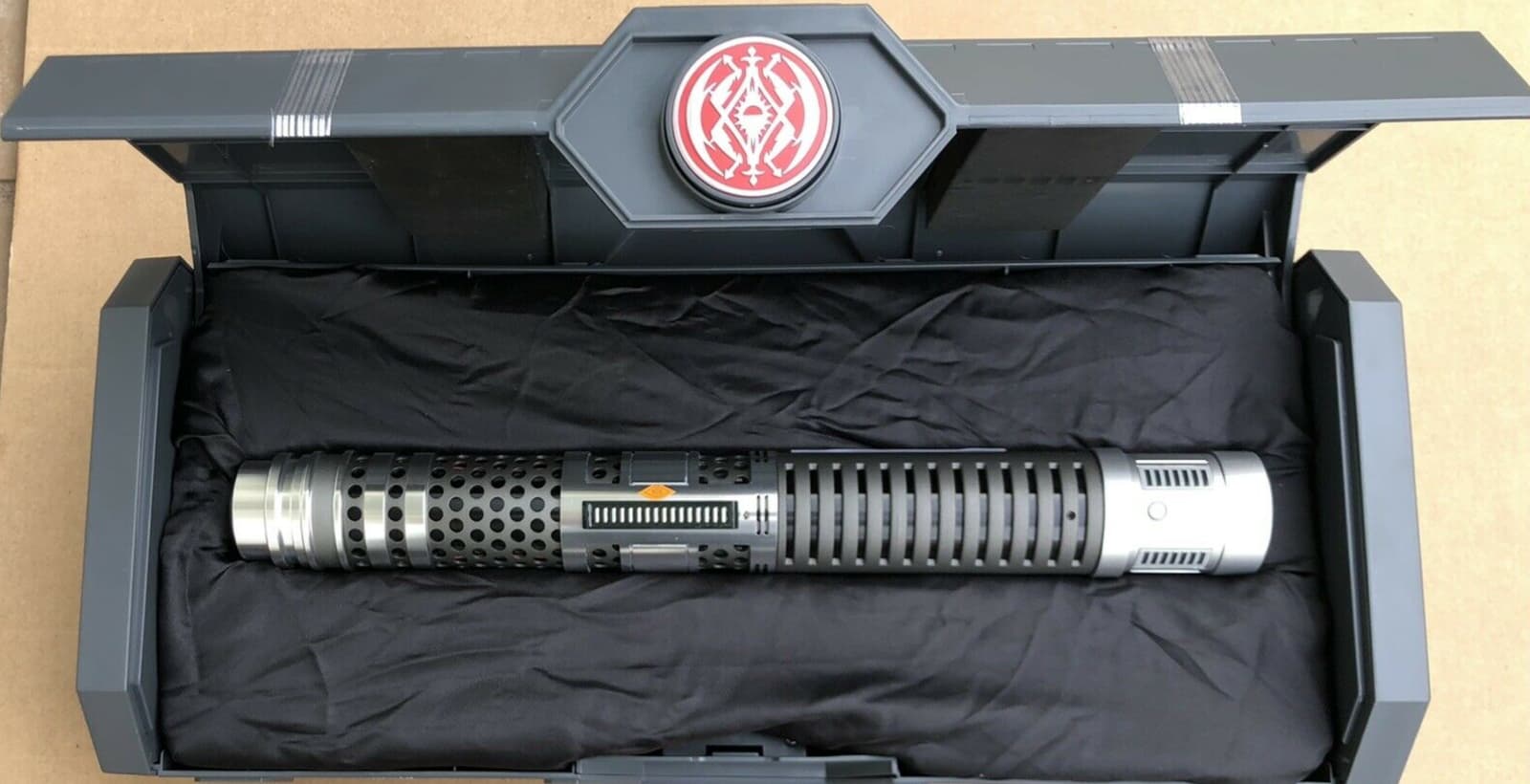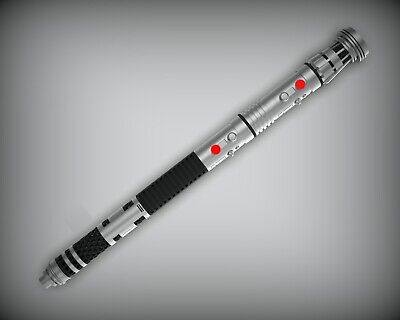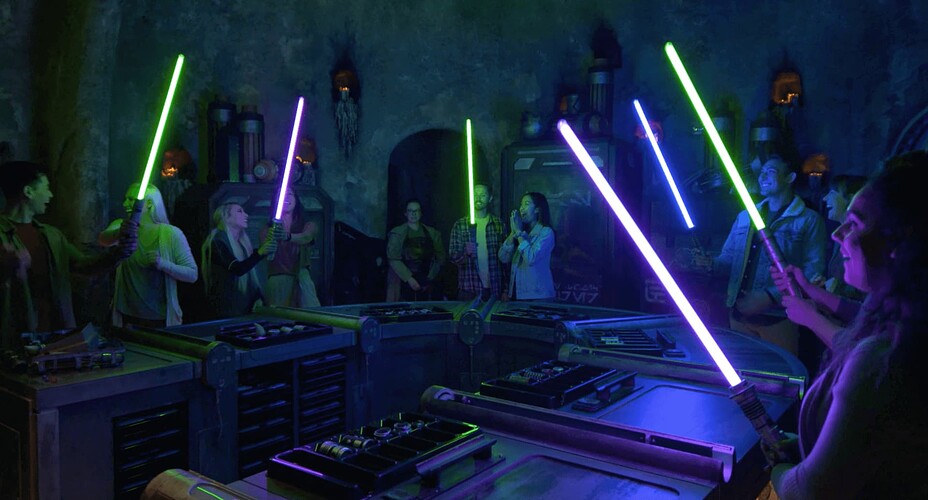I’ve started down the dark rabbit hole of lightsaber collecting. Yes, that’s lightsabers, as in the Star Wars fantasy laser sword. I’ve taken my first few steps into this wallet-draining obsessive hobby and I’m posting to see who will brave these paths with me.
A few things to note:
- There are basically three kinds of lightsabers to collect:
-
Toy - These are the plastic sabers with extendible blades that we’re all familiar with. The cheapest and easiest to collect, until you get into vintage toys and the hardcore auction market.
-
Display/Cosplay - Meant to mount on a wall or set up in your collectible case. Usually replicas of Star Wars props, but original custom designs are popular too. Often the most expensive models.
-
Dueling/Flow - Meant to be used in fight choreography, exercising, or just swinging around for fun. Usually simpler designs and built out of more durable and cheaper materials. Less detail. Up until the past few years, sabers meant for dueling had no sounds and very basic light-up blades, but as the tech has come down in price, this is no longer true. Lightsaber dueling is an officially recognized sport in France!
-
Generic Chinese import lightsabers made from aircraft aluminum start around $50 direct from Aliexpress, but prices quickly rise as you get more detailed hilts and blade or sound features. If you’re just dipping in to check out the hobby, this is where to start since you’ll only be risking a few bucks and they’re fun to just whip around. Basically, these are fancy toys that will stand up to some abuse.
-
Here is a non-comprehensive vocabulary primer:
- Hilt - The metal or resin handle of the lightsaber.
- Blade - The plastic clear or frosted blade of the saber. Comes in a standard 1in diameter size and a 7/8in version for skinnier hilts. Usually secured to the hilt via a couple of screws. Comes in Base Lit and Neopixel models. (See below.)
- Blade Plug - A chunk of blade plastic, usually about an inch long with a decorative tip to protect the open end of the hilt when a full blade isn’t inserted.
- Base Lit - Lightsaber that’s built with LEDs in the hilt that shine up into a hollow blade to create the effect of a saber. Basically a fancy flashlight. Can have sound and multiple colors for the blade. Used for dueling due to the simpler components and more durability. Usually the cheaper option.
- Duel Only - Saber with no sounds and a thick simple Base Lit blade, if it even lights up at all. Meant for serious thwacking against objects or other Duel-Only sabers. These are meant for stunt and acrobatic work and usually aren’t purchased by people not heavily into performing.
- Neopixel - Lightsaber that’s built with LEDs throughout the plastic blade so you can have features like graduated ignition, pulsing, light waves, etc. Usually more expensive than base lit sabers and the LEDs in the blade limit you to light contact dueling or you’ll risk breaking the LEDs.
- Flash-on-clash - Sound and light flash when you hit something with the lightsaber blade.
- Blaster deflection - A quick blaster noise and flash as if you’re using the blade to reflect laser fire back to the enemy.
- Smooth swing - The feature that allows the soundboard to go from a stable hum noise to the swoosh as you swing it smoothly.
- Lock-up - The sustained white light and crackle as if you’re pressing one lightsaber against another in a battle.
- Tip-drag - A feature that allows the neopixel blade to simulate the tip of the blade glowing white-hot as it’s dragged across a surface or pushed into a door.
- Sound profile - All the music, buzzing, crackling, humming and voice sounds bundled to create a distinctive theme like Luke’s lightsaber versus one that sounds like Darth Vader’s. There are folks that offer custom sounds like Thundarr’s sword or Excalibur.
- VHC - Variable Hilt Component - Parts like emitters, handles, and pommels that are largely interchangeable with other VHC parts so you can sort of design your own saber. They still tend to look like generic tubes. Mostly supplied by Chinese manufacturers.
- LGT/TXQ - Chinese manufacturers that supply many parts and whole sabers to resellers and builders throughout the world. Concentrates on value over replica fidelity. Lots of VHC sabers come from them, but they do supply some replicas, with the caveat that they aren’t movie accurate. They are cheaper than better made sabers. Note that you can buy these directly through Aliexpress, but customer support is almost non-existent and shipping times can be quite long. Starts at around $50 and goes up to hundreds of dollars for more detailed hilts.
- 89Sabers - Another Chinese supplier of sabers, but more towards the replica side, consequently they’re a bit more expensive. Same as above. You can buy direct, but most advise going through a reseller to get support and service. Starts at least around $200 and goes up from there.
- Roman - Short for Roman Props a storied lightsaber replica maker that supplied some of the props for episodes 7, 8, and 9. Very expensive and popular with DIY folks that want to order accurate parts and build their own replicas.
- Graflex - The original Skywalker lightsaber in A New Hope was built out of an old 1940’s Graflex camera flash handle. Vintage original parts are increasingly hard to find, but the hardcore replica collectors swear by them. Lightsabers made out of these tend to be for display only, though some customizers will take your Graflex parts and assemble them with neopixel cores to make them usable with a blade.
- Aniflex or Skinnyflex - The saber design used by Anakin Skywalker in episode 3, which should canonically be identical to Luke’s Graflex, was actually a custom-made prop that had major differences from the original design. Because the movie props were custom-made there are no “vintage” parts to source.
- Soundboard - Electronic innards of a saber that include a light controller, the actual sound chip, accelerometer, and in some models an SD card that allows users to use their computer to upload new sound files or light commands.
- Crystal Focus 10 (CFX), Asteria, Golden Harvest v3 (GH3), plus a long list of others. These are all saber soundboards with varying levels of functionality. Besides whether they support Base Lit or Neopixel sabers, they’re all pretty similar.
- Xenopixel - Started as a Chinese “budget” version of a neopixel board, but thanks to software updates, is now fairly comparable to more expensive units. The only drawback is that it isn’t open-source so you are dependent on manufacturer updates to add features. But if you want a cheaper neopixel setup that still allows the user to upload their own sound files and change light settings on the fly, this is a great option.
- Proffie - Considered the gold standard for neopixel saber enthusiasts. Because it is fully open source, a user can do just about anything with the lights and sounds on a Proffie setup. Of course, the open-source drawback is that if you want to do that kind of thing, you’ll need to roll up your sleeves and get programming and use some obtuse software.
- Covertec Wheel - The little round bit on the end of some lightsabers that allow the Jedi or Sith to attach it to their belt. Yes, it’s the same doohickey as the ones people used to use for their cell phones and belt holsters. All prequel trilogy sabers use Covertec Wheels.
- D-Ring/Ring/Triangle Ring - Instead of Covertec Wheels, all original trilogy sabers use a ring and hook system to attach to the users belt.
- Stunt Saber - When they filmed the movies, the heavy fight scenes were done with stunt versions of sabers, usually made of very light materials painted to resemble the “hero” sabers. Some people actually like to collect or make replicas of these props.
- Disney’s Legacy/Galaxy’s Edge lightsabers offer a relatively cheap (starting around $150) way to get a replica saber with some pixel blade functionality. There are some caveats:
- Replicas resemble their movie counterparts, but there are concessions made for expense and the fact that these are meant for 8-year-olds and up to use while in the parks. If you’re looking for “screen used prop” accuracy, look elsewhere.
- Blades are sold separately, but they are interchangeable and simple to swap out with no tools needed. Again, they are meant for kids to use as well as adults.
- All sabers are slightly thicker than their movie props due to the way the blades work with the hilts. This can lead to bulky hilts like Palpatine’s saber that aren’t easy to hold.
- Sound and light quality are noticeably lesser than neopixel sabers. Common criticisms include dull lights, slow or unresponsive swinging effects, and tinny sounds.
- Most models come with a neat plastic container that doubles as a display.
- Officially available only in Disney parks, so if you don’t visit, you have to use the secondary market like eBay. Still, even with the uplift most sellers charge, they are in demand with fans.
-
Most of the above issues go likewise for Hasbro’s Black series of sabers, with the exception that you can buy them online at Hasbro’s site or any number of official partner stores.
-
A video to show the lengths replica folks will go to:
- The replica lightsaber community’s bible.



